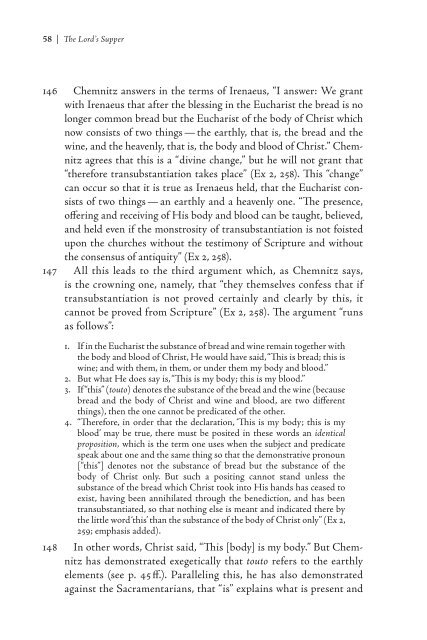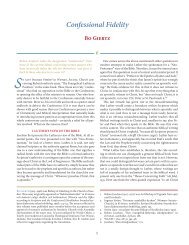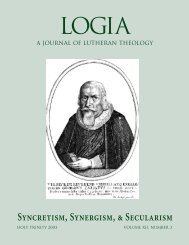The Lord's Supper in the Theology of Martin Chemnitz Bjarne - Logia
The Lord's Supper in the Theology of Martin Chemnitz Bjarne - Logia
The Lord's Supper in the Theology of Martin Chemnitz Bjarne - Logia
You also want an ePaper? Increase the reach of your titles
YUMPU automatically turns print PDFs into web optimized ePapers that Google loves.
| <strong>The</strong> Lord’s <strong>Supper</strong><br />
146 <strong>Chemnitz</strong> answers <strong>in</strong> <strong>the</strong> terms <strong>of</strong> Irenaeus, “I answer: We grant<br />
with Irenaeus that after <strong>the</strong> bless<strong>in</strong>g <strong>in</strong> <strong>the</strong> Eucharist <strong>the</strong> bread is no<br />
longer common bread but <strong>the</strong> Eucharist <strong>of</strong> <strong>the</strong> body <strong>of</strong> Christ which<br />
now consists <strong>of</strong> two th<strong>in</strong>gs — <strong>the</strong> earthly, that is, <strong>the</strong> bread and <strong>the</strong><br />
w<strong>in</strong>e, and <strong>the</strong> heavenly, that is, <strong>the</strong> body and blood <strong>of</strong> Christ.” <strong>Chemnitz</strong><br />
agrees that this is a “div<strong>in</strong>e change,” but he will not grant that<br />
“<strong>the</strong>refore transubstantiation takes place” (Ex 2, 258). This “change”<br />
can occur so that it is true as Irenaeus held, that <strong>the</strong> Eucharist consists<br />
<strong>of</strong> two th<strong>in</strong>gs — an earthly and a heavenly one. “<strong>The</strong> presence,<br />
<strong>of</strong>fer<strong>in</strong>g and receiv<strong>in</strong>g <strong>of</strong> His body and blood can be taught, believed,<br />
and held even if <strong>the</strong> monstrosity <strong>of</strong> transubstantiation is not foisted<br />
upon <strong>the</strong> churches without <strong>the</strong> testimony <strong>of</strong> Scripture and without<br />
<strong>the</strong> consensus <strong>of</strong> antiquity” (Ex 2, 258).<br />
147 All this leads to <strong>the</strong> third argument which, as <strong>Chemnitz</strong> says,<br />
is <strong>the</strong> crown<strong>in</strong>g one, namely, that “<strong>the</strong>y <strong>the</strong>mselves confess that if<br />
transubstantiation is not proved certa<strong>in</strong>ly and clearly by this, it<br />
cannot be proved from Scripture” (Ex 2, 258). <strong>The</strong> argument “runs<br />
as follows”:<br />
1. If <strong>in</strong> <strong>the</strong> Eucharist <strong>the</strong> substance <strong>of</strong> bread and w<strong>in</strong>e rema<strong>in</strong> toge<strong>the</strong>r with<br />
<strong>the</strong> body and blood <strong>of</strong> Christ, He would have said,“This is bread; this is<br />
w<strong>in</strong>e; and with <strong>the</strong>m, <strong>in</strong> <strong>the</strong>m, or under <strong>the</strong>m my body and blood.”<br />
2. But what He does say is,“This is my body; this is my blood.”<br />
3. If “this” (touto) denotes <strong>the</strong> substance <strong>of</strong> <strong>the</strong> bread and <strong>the</strong> w<strong>in</strong>e (because<br />
bread and <strong>the</strong> body <strong>of</strong> Christ and w<strong>in</strong>e and blood, are two different<br />
th<strong>in</strong>gs), <strong>the</strong>n <strong>the</strong> one cannot be predicated <strong>of</strong> <strong>the</strong> o<strong>the</strong>r.<br />
4. “<strong>The</strong>refore, <strong>in</strong> order that <strong>the</strong> declaration, ‘This is my body; this is my<br />
blood’ may be true, <strong>the</strong>re must be posited <strong>in</strong> <strong>the</strong>se words an identical<br />
proposition, which is <strong>the</strong> term one uses when <strong>the</strong> subject and predicate<br />
speak about one and <strong>the</strong> same th<strong>in</strong>g so that <strong>the</strong> demonstrative pronoun<br />
[“this”] denotes not <strong>the</strong> substance <strong>of</strong> bread but <strong>the</strong> substance <strong>of</strong> <strong>the</strong><br />
body <strong>of</strong> Christ only. But such a posit<strong>in</strong>g cannot stand unless <strong>the</strong><br />
substance <strong>of</strong> <strong>the</strong> bread which Christ took <strong>in</strong>to His hands has ceased to<br />
exist, hav<strong>in</strong>g been annihilated through <strong>the</strong> benediction, and has been<br />
transubstantiated, so that noth<strong>in</strong>g else is meant and <strong>in</strong>dicated <strong>the</strong>re by<br />
<strong>the</strong> little word‘this’ than <strong>the</strong> substance <strong>of</strong> <strong>the</strong> body <strong>of</strong> Christ only” (Ex 2,<br />
259; emphasis added).<br />
148 In o<strong>the</strong>r words, Christ said, “This [body] is my body.” But <strong>Chemnitz</strong><br />
has demonstrated exegetically that touto refers to <strong>the</strong> earthly<br />
elements (see p. 45 ff.). Parallel<strong>in</strong>g this, he has also demonstrated<br />
aga<strong>in</strong>st <strong>the</strong> Sacramentarians, that “is” expla<strong>in</strong>s what is present and




